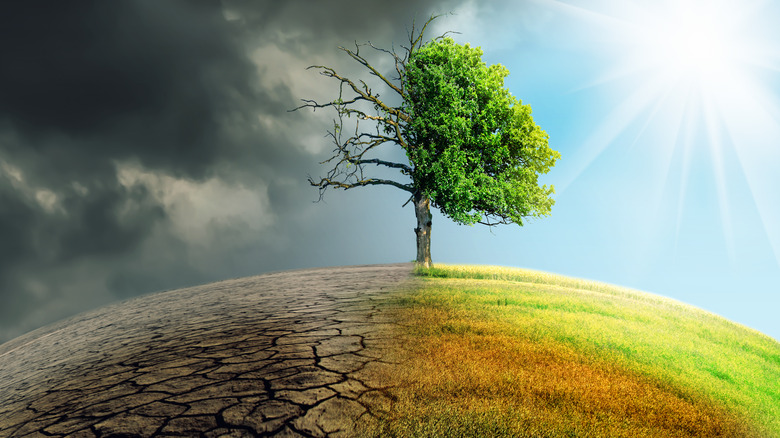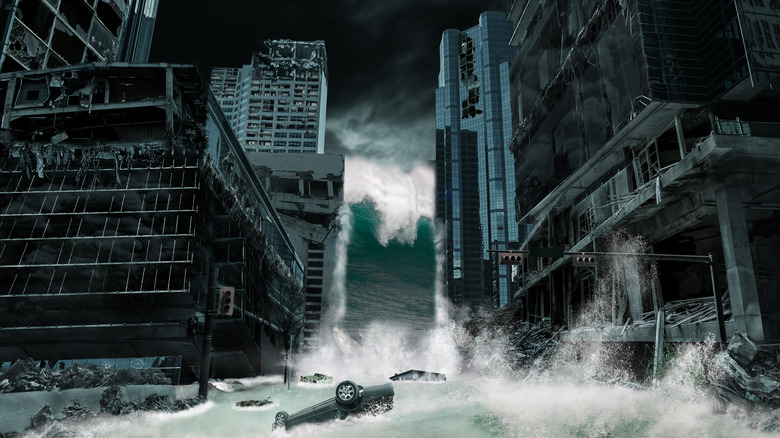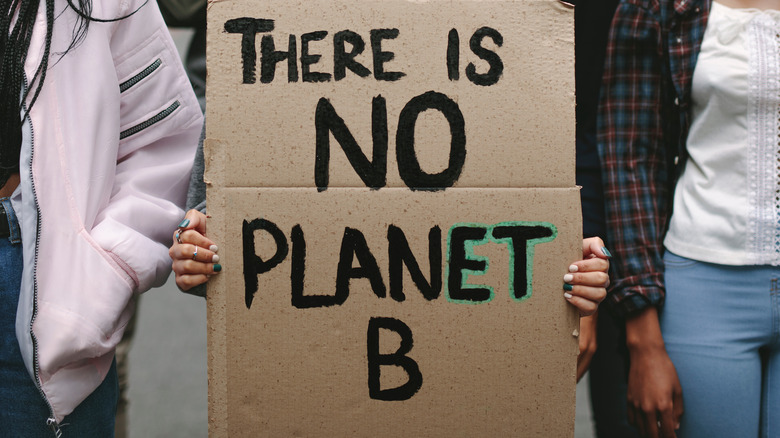The Truth About The Black Box Recording The End Of Civilization
If this whole "self-aware ape" (read: human) experiment finally takes humanity the way of the dodo, it might be nice to at least leave some record of things — a warning for future, sentient life that arises on Earth. Or a big planetary sign for aliens that says, "Warning: Toxic Danger Zone"? Maybe a clip of Mozart, a Michelangelo sculpture, or at least a photo of Keanu Reeves?
Let's be honest: it's not too kooky to assume that humans are going to go extinct. As the American Museum of Natural History outlines, there have been five "top" extinction events (implying more), starting 440 million years ago with the Ordovician-silurian Extinction that obliterated lots of marine life. The last extinction event — the "K-T" extinction 65 million years ago that wiped out the dinosaurs — paved the way for mammals like us. Extinction is a natural part of Earth's ongoing development. That, however, doesn't include man-made problems like climate change, nuclear launch codes, and rampant tribalism.
So maybe some kind of record would be a good idea — a "black box," so to speak. We've already cast the Golden Record out into the cosmos on the Voyager spacecraft in 1977, as NASA recalls, to get far, far away from Earth. It's kind of a snapshot of humanity full of images, sounds, music, and multilingual greetings. Alien civilizations take note: we were here.
Meanwhile on Earth, Tasmania has been chosen as the site for a solar panel-powered, "big-ass steel box" (per Pedestrian). Its mission is to chronicle our downfall.
A 24-7, half-century recording of humanity's demise
The Earth's Black Box website (the project's official name) says it all on their front page. It's worth quoting in full:
"Unless we dramatically transform our way of life, climate change and other man-made perils will cause our civilization to crash. Earth's Black Box will record every step we take towards this catastrophe. Hundreds of data sets, measurements, and interactions relating to the health of our planet will be continuously collected and safely stored for future generations. The purpose of this device is to provide an unbiased account of the events that lead to the demise of the planet, hold accountability for future generations, and inspire urgent actions. How the story ends is completely up to us. Only one thing is certain, your actions, inactions, and interactions are now being recorded."
Scroll down from this dire declaration and you can see real-time, updated text gathered from across the entire world about "measures of ocean and land temperatures, atmospheric carbon dioxide, changes to land use, energy consumption, and population growth," and more, as Gizmodo explains.
The 33-foot-long (10 meters) steel structure, which is backed up by batteries, was designed to hold half a century's worth of data, if not more. Similar to NASA's Golden Record, its data would only be able to be accessed and deciphered by another advanced civilization, terrestrial or otherwise. Such a civilization might run headlong into habits as disastrous as ours, and wisdom just as lacking. Guidance might be warranted.
Art showpiece, or useful deterrent?
Earth's Black Box is a collaborative, non-profit project from the University of Tasmania, Clemenger BBDO (a communications firm), and the Glue Society (an art collective). As Gizmodo says, the team considered Malta, Qatar, and Norway (home of the Svalbard Global Seed Vault) before settling on Tasmania for its "favorable geopolitical and geological stability."
The black box is supposed to begin construction in 2022 but it started recording data during the recent 2021 COP26 climate conference in Glasgow, Scotland. As for any, actually actionable, agreed-upon resolutions from that conference? Well, let's just say that the conference made the need for a black box even more apparent (Gizmodo has a good summary).
Some have criticized Earth's Black Box for being more of an art installation rather than any kind of useful inspiration for taking action to prevent the apocalypse. It does come with its own Instagram account, we admit. Some have likened it to the Climate Clock, a literal clock installed at various locations around the world, starting with New York in 2020, that counts down how much time is left until we need to reach zero carbon emissions.
But the black box's 3-inch-thick casing made of "indestructible" steel and full of storage drives' true purpose may not be a type of activism so much as an acceptance of defeat. Installing Earth's Black Box on the plains of Tasmania might not change a thing, it's true — but neither will ignoring it or dismissing it — just like climate change.


